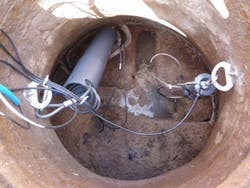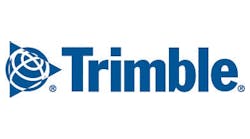With its major business district and residential developments flanking the Thames River, London, ON, began to recognize the issues inherent in its aging combined sewer system as early as the 1950s. The scattered sewers, built 100 years earlier, addressed water management issues in specific areas but were not constructed to function as a complete system.
The Problem
A project in the late 1890s connected the combined sewers to a trunk sewer system, bringing the sewage to the Greenway Pollution Control Centre. As development increased during the first half of the twentieth century, however, London saw a new problem come into play: basement flooding in its downtown core. To alleviate this issue, London constructed large, deep storm relief sewers that removed the water from commercial and residential areas but discharged untreated storm overflows into the Thames River.
London moved away from these combined sewer overflows (CSOs) in the 1950s, constructing separate sanitary and storm sewers for new developments. However, more than 280 CSOs still remain in the metropolitan area.
At various times of the year, sanitary sewers fill with melted snow and spring runoff, causing them to overflow and leading to basement flooding. In January 2008, more than 150 basements flooded when a 30-cm snowpack melted during two major rainstorms. Engineers calculated the total effect, finding the resulting water level roughly equivalent to that of a 10-year storm.
“We know we have a problem, but we don’t know if we have problems with the CSOs,” said Scott Mathers, MPA, P.E., environmental services engineer for the City of London and CSO program manager. “To allow for growth, we need to know how the system behaves in a storm. We don’t have a good understanding of when the CSOs are spewing sewage. We need good quality flow monitoring information to protect resident health, accommodate the city’s growth and protect the health of the Thames River.”
The City of London’s engineers did their best to monitor storm water situations and the behavior of its CSOs, but the high-maintenance monitoring system in place did not provide the reliable, consistent information the city needed to determine the exact sources of the overflow problems.
“We had to go out every two or three weeks to download data from the monitors we had,” said Mathers. “Commonly, we’d install a flow monitor, the sensor would foul up the following day and then we wouldn’t get out there for another three weeks to check the monitor. We were losing a lot of data. If we were doing six months of flow monitoring on a sewer reconstruction project and we’d lose three weeks of data from the monitor, that wasn’t acceptable. Good quality flow monitoring information is very important to helping us find the problems.”
“With inclement weather, downloading the data becomes a lot of effort,” said Paul Marchello, an engineering technologist with the City of London and one of the leads on the project. “We have a couple in the middle of a field, so when it snows, it takes lots of equipment and men to go out and get the data. Also, a lot of the trunk sewers are under major roads. I’m the one who has to go out and get the data, so to reach the monitors, I’d have to stop traffic and open the manhole. Then if there’s been an equipment failure—if the sensors get gummed up with debris or tangled in rags that come through the sewage system—we could lose several weeks of data.”
The Solution
With all of these challenges in mind, London developed the Strategic Flow Monitoring Initiative. The plan called for collecting complete, accurate sewer flow and rainfall data to be used in modeling activities for capital and development projects while establishing permanent monitoring stations that would develop a long-term flow record in critical areas in and around the city. A reduction in the incidences of lost data was a critical component in the plan. “Our objective is to reduce the number of overflows by understanding what’s really happening,” said Marchello.
In addition, the plan’s objectives included a reduction in the health and safety risks associated with accessing manholes in high-traffic areas on a regular basis.
The city’s engineers agreed that it was time to take the next step in improving the wastewater management system: moving to remote monitoring, using flow monitors that transmit data directly to the municipality’s computer system at intervals set by the engineers, thus eliminating the need to send workmen out to download data underground in the middle of busy streets.
Marchello, Mathers and Mark Spitzig—the third staff member involved in the plan—contacted Ken MacDonald at Can-Am Instruments Ltd., a distributor of industrial process controls and environmental instrumentation. With MacDonald’s help, they chose to link their existing Hach Sigma 910 flowmeters with Telog Ru-33 recording telemetry units (RTUs), data collection devices made specifically for harsh sewer environments. Telog RTUs monitor water level, flow, pressure and water quality, operating on a 6-VDC lantern battery. Each unit forwards data wirelessly to a host computer at the utility’s operations center, so no hardwired phone or electrical lines are required.
“I’d been out in the field to download data with London’s crews, and in winter, with slippery roads, stopping traffic and popping a manhole cover was very dangerous,” said MacDonald. “I’d seen some near misses. With the Telog units, no one needs to go to the monitor in a manhole to retrieve the data.”
To receive and analyze the data, London selected Telogers Enterprise information management software—a comprehensive, scalable system that is compatible with virtually every existing software package municipalities may already own, including SCADA. With the new software and an intensive training session run by Telog systems support manager Jacek Megiel, the London operations center has the capability to view information in real time, make comparisons with historical data and link with popular modeling software to use the data to predict upcoming problems in the event of storms, record snowmelt and other hazards.
“Now we don’t have people out in the middle of the roads, in the manholes,” Mathers said. “The data is sent wirelessly to our computer, and we can access the data from anywhere online—even from home. We don’t have to transport large amounts of data back and forth.”
London began with seven Telog RTUs and expanded the program to 19 units in 2009. Continued expansion will include the launch of a rainfall-monitoring program and full integration with the existing SCADA system.
The Results
By eliminating the maintenance, power and data access issues inherent in London’s previous monitoring system, the municipality can gather more data than ever before, finding problem areas and determining solutions for the issues the data bring to light.
[Visit Telog's W&WD Storefront]
“In Canada, we have criteria that require municipalities to understand the amount of overflow from the conveyance system and our treatment plants,” Mathers said. “We want to have an accurate reading of wet weather flow, so we can further understand what kind of projects we need to develop to fix these problems. We have a lot of consultants who tell us they can fix the problem, but we don’t even know what the problem is. It’s easy to say that we can construct a large public work that will reduce overflows, but we don’t want to just throw huge amounts of money at a system when we may be able to fix it with a real-time control solution using existing system capacity. There’s a lot we can do with a lower capital cost and lower operations and maintenance costs.”


